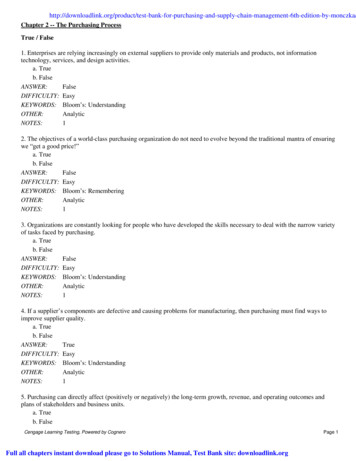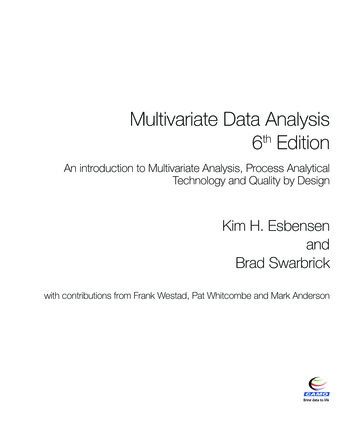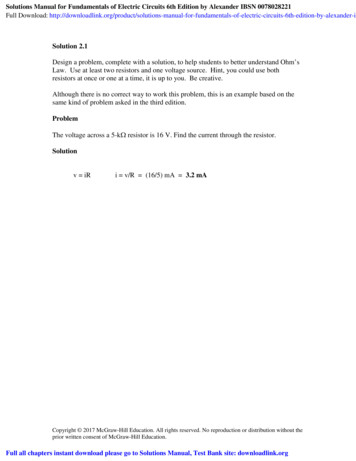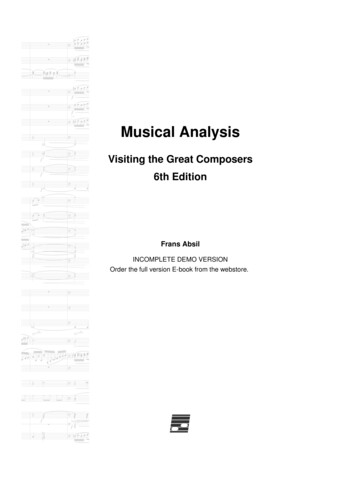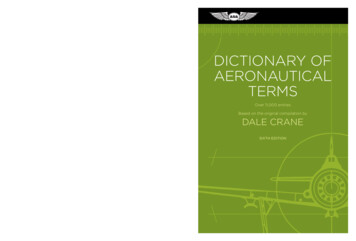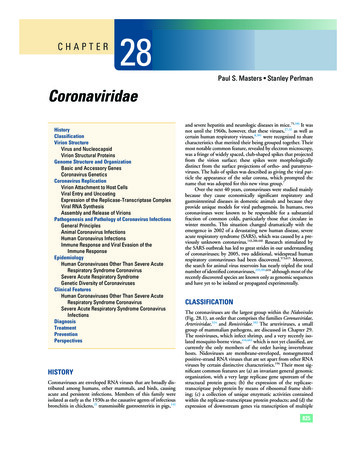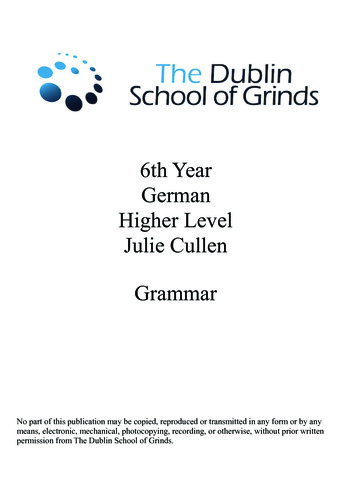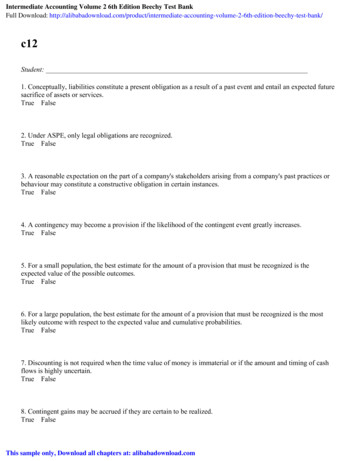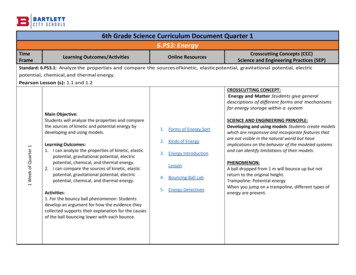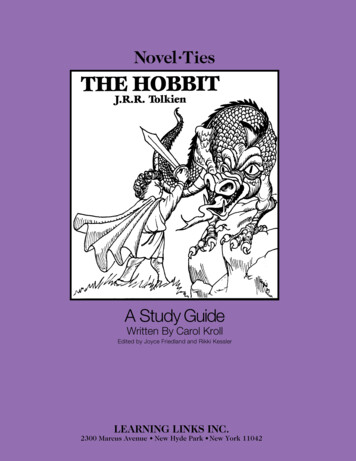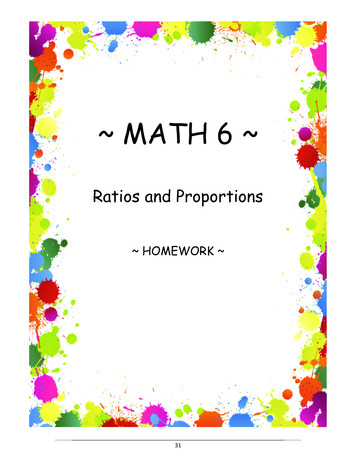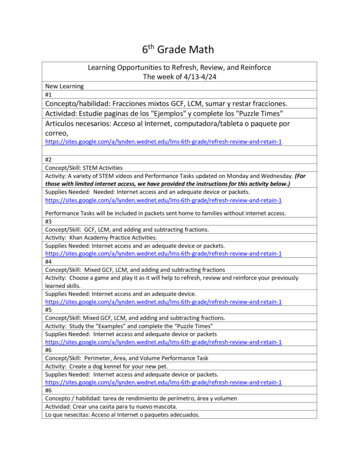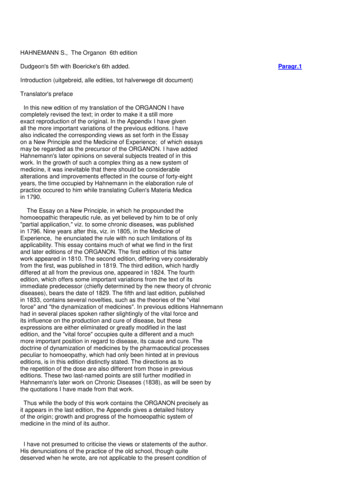
Transcription
HAHNEMANN S., The Organon 6th editionDudgeon's 5th with Boericke's 6th added.Introduction (uitgebreid, alle edities, tot halverwege dit document)Translator's prefaceIn this new edition of my translation of the ORGANON I havecompletely revised the text; in order to make it a still moreexact reproduction of the original. In the Appendix I have givenall the more important variations of the previous editions. I havealso indicated the corresponding views as set forth in the Essayon a New Principle and the Medicine of Experience; of which essaysmay be regarded as the precursor of the ORGANON. I have addedHahnemann's later opinions on several subjects treated of in thiswork. In the growth of such a complex thing as a new system ofmedicine, it was inevitable that there should be considerablealterations and improvements effected in the course of forty-eightyears, the time occupied by Hahnemann in the elaboration rule ofpractice occured to him while translating Cullen's Materia Medicain 1790.The Essay on a New Principle, in which he propounded thehomoeopathic therapeutic rule, as yet believed by him to be of only"partial application," viz. to some chronic diseases, was publishedin 1796. Nine years after this, viz. in 1805, in the Medicine ofExperience, he enunciated the rule with no such limitations of itsapplicability. This essay contains much of what we find in the firstand later editions of the ORGANON. The first edition of this latterwork appeared in 1810. The second edition, differing very considerablyfrom the first, was published in 1819. The third edition, which hardlydiffered at all from the previous one, appeared in 1824. The fourthedition, which offers some important variations from the text of itsimmediate predecessor (chiefly determined by the new theory of chronicdiseases), bears the date of 1829. The fifth and last edition, publishedin 1833, contains several novelties, such as the theories of the "vitalforce" and "the dynamization of medicines". In previous editions Hahnemannhad in several places spoken rather slightingly of the vital force andits influence on the production and cure of disease, but theseexpressions are either eliminated or greatly modified in the lastedition, and the "vital force" occupies quite a different and a muchmore important position in regard to disease, its cause and cure. Thedoctrine of dynamization of medicines by the pharmaceutical processespeculiar to homoeopathy, which had only been hinted at in previouseditions, is in this edition distinctly stated. The directions as tothe repetition of the dose are also different from those in previouseditions. These two last-named points are still further modified inHahnemann's later work on Chronic Diseases (1838), as will be seen bythe quotations I have made from that work.Thus while the body of this work contains the ORGANON precisely asit appears in the last edition, the Appendix gives a detailed historyof the origin; growth and progress of the homoeopathic system ofmedicine in the mind of its author.I have not presumed to criticise the views or statements of the author.His denunciations of the practice of the old school, though quitedeserved when he wrote, are not applicable to the present condition ofParagr.1
allopathic medicine. It is beyond all question that it was mainlyowing to the treatment and practice of Hahnemann and his disciplesthat the disastrous methods in vogue for centuries previous to and farinto his time have been abandoned. It remains, however, doubtful ifthe allopathic methods of the present day have any greater claim toscientific character or success than those they have superseded. WereHahnemann alive now we can easily imagine how he would have inveighedagainst the school-medicine of the present day. The tonic, stimulant,antipyretic and narcotic practice of modern medicine is as far removedfrom the scientific simplicity of homoeopathy as were thevenesections, blisters, cauteries, purgatives and mercurialisationsagainst which Hahnemann waged successful war. Hahnemann's vigorousprotest against the dominant medicine of his day is useful as showingthe negative good effects of homoeopathy; for almost all theirrational practices he denounced have been abandoned; it remains forhis followers to exhibit its positive effects in the victory ofrational and scientific medicine.I am indebted to Dr. Richard Hughes for several emendations of myfirst translation, whereby the author's meaning has been rendered moreexact and clearer; also for some rectifications of Hahnemann's quotationsand for the idea of a comparative table or concordance of the aphorismsin the several editions, which he gave in the British Journal ofHomoeopathy, vol.xxxix.The referencesin the text to the notes in the Appendix are indicated by the sign"(a)", and some needful explanatory notes are enclosed in squarebrackets, or divided from the text by a line. The latter are confinedto the quotations in the Appendix.March, 1893R.E. DUDGEON.PREFACE TO THE FIRST EDITIONACCORDING to the testimony of all ages, no occupation is more unanimouslydeclared to be a conjectural art than medicine; consequently none has lessright to refuse a searching enquiry as to whether it is well founded than it,on which man's health, his most precious possession on earth, depends.I consider that it redounds to my honour that I am the only one in recenttimes who has subjected it to a serious honest investigation, and hascommunicated to the world the results of his convictions in writingspublished, some with, some without my name.In this investigation I found the way to the truth, but I had to treadit alone, very far from the common highway of medical routine. The farther Iadvanced from truth to truth, the more my conclusions (none of which Iaccepted unless confirmed by experience) led me away from the old edifice,which, being built up of opinions, was only maintained by opinions.The results of my convictions are set forth in this book.It remains to be seen whether physicians, who mean to act honestly bytheir conscience and by their fellow-creatures, will continue to stick to thepernicious tissue of conjectures and caprice, or can open their eyes to thesalutary truth.I must warn the reader that indolence, love of ease and obstinacy precludeeffective service at the altar of truth, and only freedom from prejudice andMain
untiring zeal qualify for the most sacred of all human occupations, thepractice of the true system of medicine. The physician who enters on his workin this spirit becomes directly assimilated to the Divine Creator of theworld, whose human creatures he helps to preserve, and whose approval rendershim thrice blessed.SAMUEL HAHNEMANN LEIPZIG, 1810PREFACE TO THE SECOND EDITIONPHYSICIANS are my brethren; I have nothing against them personally.The medical art is my subject.I have to inquire whether medicine as hitherto taught has, in allits parts, been merely developed out of the heads, the self-deceptionand the caprice of its professors, or whether it has been derived fromnature.If it be merely a product of speculative subtlety, arbitrarymaxims, traditional practices and capricious deductions drawn fromambiguous premises, it is and remains a nullity, though it may reckonits age by thousands of years, and be decorated with the charters ofall the kings and emperors of the earth.The true healing art is in its nature a pure science of experience,and can and must rest on clear facts and on the sensible phenomenapertaining to their sphere of action, for all the subjects it ha- todeal with are clearly and satisfactorily cognizable by the sensesthrough experience. Knowledge of the disease to be treated, knowledgeof the effects of the medicines, and how the ascertained effects ofthe medicines are to be employed for the removal of diseases, all thisexperience alone teaches adequately. Its subjects can only be derivedfrom pure experiences and observations, and it dares not take a singlestep out of the sphere of pure well-observed experience andexperiment, if it would avoid becoming a nullity, a farce.But that the whole art of medicine as hitherto practised, though ithas been, for want of something better, practised for these 2500 yearsby millions of physicians, many of whom were earnest high-minded men,is yet in every respect an extremely stupid, useless and thoroughlynull affair, is proved by the following few incontrovertibleconsiderations.Unaided reason can know nothing of itself (a priori), can evolveout of itself alone no conception of the nature of things, of causeand effect; every one of its conclusions about the actual must alwaysbe based on sensible perceptions, facts and experiences if it wouldelicit the truth. If in its operation it should deviate by a singlestep from the guidance of perception, it would lose itself in theillimitable region of phantasy and of arbitrary speculation, themother of pernicious illusion and of absolute nullity.In the pure sciences of experience, in physics, chemistry andmedicine, merely speculative reason can consequently have no voice;there when it acts alone, it degenerates into empty speculation andphantasy, and produces only hazardous hypotheses, which in millions ofinstances are, and by their very nature must be, self-deception andfalsehood.Such has hitherto been the splendid juggling of so-calledtheoretical medicine, in which a priori conceptions and speculative
subtleties raised a number of proud schools, which only showed whateach of their founders had dreamed about things which could not beknown, and which were of no use for the cure of diseases.Out of these sublime systems, soaring far beyond all experience,medical practice could obtain nothing available for actual treatment.So it pursued its course confidently at the patient's bedside inaccord with the traditional prescriptions of its books telling howphysicians had hitherto treated, and in conformity with the methods ofits practical authorities, unconcerned, like them, about the teachingsof nature-guided experience, unconcerned about true reasons for itstreatment, and quite content with the key to easy practice -- theprescription book.A healthy, unprejudiced, conscientious examination of thisconfused business shows plainly that what has hitherto gone by thename of "the art of medicine" was merely a pseudo-scientificfabrication, remodelled from time to time to meet the prevailingfashion in medical systems, like Gellert's hat in the fable, but, asregards the treatment of disease, ever the same blind perniciousmethod.A healing art conformable to nature and experience did not exist.Everything in traditional medicine was the outcome of art andimagination, having no foundation in experience, but pranked out inthe habiliments of probability.The object of cure (the disease) was manufactured to order bypathology. It was arbitrarily settled what diseases, how many and whatforms and kinds there should be. Just think! The whole range ofdiseases, produced in innumerable and always unforeseeable variety byinfinite Nature in human beings exposed to thousands of differentconditions, the pathologist cuts down so ruthlessly that a merehandful of cut and dry forms is the result!The wiseacres define diseases a priori, and attributed to themtranscendental substrata not warranted by experience (how could plainpure experience ever sanction such fantastic dreams?); no! theypretended to possess an insight into the inner nature of things andthe invisible vital processes, which no mortal can have.Now, in order to decide on something positive with regard to theinstruments of cure, the powers of the different medicines in themateria medica were inferred from their physical, chemical and otherirrelevant qualities, also from their odour, taste and externalaspect, but chiefly from impure experiences at the sick bed, where, inthe tumult of the morbid symptoms, only mixtures of medicines wereprescribed for imperfectly described cases of disease. Just think! thedynamic spiritual power of altering man's health hidden in theinvisible interior of medicines, and never manifested purely and trulyin any other way than by their effects on the healthy human body, wasarbitrarily ascribed to them, without interrogating the medicinesthemselves in this only admissible way of pure experiment, andlistening to their response when so questioned!Then therapeutics taught how to apply the medicines, whosequalities had been thus inferred, ascribed or imagined, to thesupposed fundamental cause or to single symptoms of disease, inconformity with the rule contraria contrariis of the hypothesis-framerGalen, and in direct opposition to nature; and this doctrine was heldto be more than sufficiently established if eminent authorities could
be adduced in support of it.All these unnatural human doctrines, after being connected togetherby all sorts of illogical false deductions, were then welded intoscholastic forms by the noble art that devotes itself to division,subdivision and tabellation, and lo! the manufactured article, the artof medicine, was ready for use, -- a thing the most opposed to natureand experience it is possible to conceive, a structure built upentirely of the opinions of various kinds furnished by thousands ofdifferently constituted minds. In all its parts this edifice is a purenullity, a pitiable self-deception, eminently fitted to imperil humanlife by its methods of treatment, blindly counter to the end proposed,incessantly ridiculed by the wisest men of all ages, and labouringunder the curse of not being what it professes to be, and not beingable to perform what it promises.Sober, unprejudiced reflection, on the other hand, can easilyconvince us that to hold correct views about every case of disease wehave to cure, to obtain an accurate knowledge of the true powers ofmedicines, to employ them on a plan adapted to each morbid conditionand to administer them in proper dose, -- in a word, the complete truehealing art, can never be the wo
fashion in medical systems, like Gellert's hat in the fable, but, as regards the treatment of disease, ever the same blind pernicious method. A healing art conformable to nature and experience did not exist. Everything in traditional medicine was the outcome of art and imagination, having no foundation in experience, but pranked out in the habiliments of probability. The object of cure (the .
